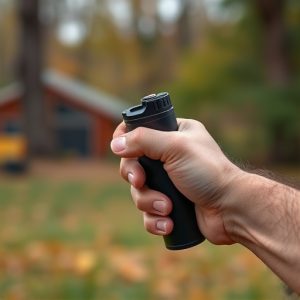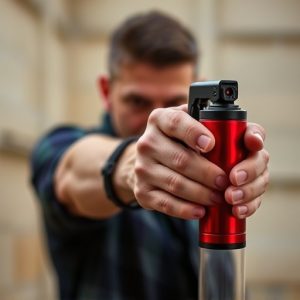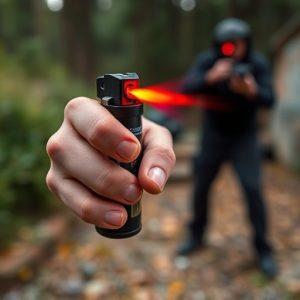Pepper Spray Defense Against Dogs: Law Enforcement Guide
Pepper spray, a crucial tool in law enforcement, is employed for crowd control and managing dog-rela…….
Pepper spray, a crucial tool in law enforcement, is employed for crowd control and managing dog-related incidents. It temporarily incapacitates aggressive dogs, ensuring officer safety and allowing assessment without causing permanent harm. With proper training, officers learn defensive positioning and precise aiming to deploy pepper spray against dogs as a last resort, balancing public safety with animal welfare. Rigorous drills prepare them for unique challenges in riot control scenarios involving humans and animals. The legal framework governs its use, emphasizing proportionality and necessity while prioritizing individual rights and animal welfare.
Riot control agents, particularly pepper spray, have become integral tools in law enforcement’s arsenal for managing chaotic situations. This article offers a comprehensive guide tailored for officers to understand and master pepper spray defense against dogs. We explore its mechanics, role in dog-related incidents, legal frameworks governing its use, and practical training methods. By the end, readers will grasp the tactical implementation of pepper spray, ensuring safe and effective crowd control while minimizing harm to animals.
- Understanding Riot Control Agents: An Overview for Law Enforcement
- Pepper Spray and Its Role in Dog-Related Incidents
- Legal Considerations and Regulations Surrounding Pepper Spray Use
- Training and Tactical Implementation for Effective Pepper Spray Defense
Understanding Riot Control Agents: An Overview for Law Enforcement
Riot control agents, often referred to as less-lethal or non-lethal weapons, are a crucial tool for law enforcement agencies when dealing with civil disturbances and crowd control situations. These agents are designed to disrupt and disperse rioters or protesters without causing serious physical harm, providing an alternative to deadly force. One of the most common and widely used riot control agents is pepper spray, which has become a staple in many police departments worldwide.
When confronted with aggressive dogs during disturbances, law enforcement officers can utilize specialized equipment like pepper spray to defend themselves and control the situation. Pepper spray creates a burning sensation and temporary blindness by targeting the eyes and respiratory system of both humans and animals. This non-deadly force can help officers de-escalate conflicts involving dogs, ensuring the safety of both citizens and law enforcement personnel. Understanding how to effectively deploy pepper spray, including its range, effectiveness against dogs, and proper use in crowd control scenarios, is essential training for modern police forces.
Pepper Spray and Its Role in Dog-Related Incidents
Pepper spray, a widely used riot control agent, has become an essential tool for law enforcement during crowd control situations. However, its applications extend far beyond riot scenarios. One specific area where pepper spray plays a crucial role is in dealing with dog-related incidents. When faced with aggressive or unpredictable canines, officers can deploy pepper spray as a defense mechanism to protect themselves and the public. This non-lethal agent temporarily incapacitates the dog, providing an opportunity for officers to assess the situation and take appropriate action without causing permanent harm.
In many instances, dogs, especially those in distress or under the influence of fear or anger, can pose a significant threat. Pepper spray offers a strategic advantage by offering a quick response that disrupts the dog’s behavior pattern. Its use requires careful consideration and training to ensure the safety of both officers and animals. With proper protocol in place, pepper spray defense against dogs has proven to be an effective measure, promoting public safety while minimizing the potential impact on animal welfare.
Legal Considerations and Regulations Surrounding Pepper Spray Use
The legal landscape surrounding pepper spray use in law enforcement is complex and varies across jurisdictions, but it generally reflects a delicate balance between public safety and individual rights. In many regions, officers are permitted to employ pepper spray as a non-lethal force option when confronting dangerous situations, including attacks by dogs. However, strict protocols and training regulations govern its deployment to ensure responsible and accountable use.
Key legal considerations involve proportionality and necessity. Pepper spray can only be employed when less lethal options have been exhausted or are not feasible, and it must be used in a manner that is proportionate to the perceived threat. In addition, specific regulations often dictate when and how officers can deploy pepper spray against dogs, with provisions for animal welfare and the safety of bystanders. These rules ensure that pepper spray is used as a defensive measure against dogs, such as during unprovoked attacks or when other de-escalation tactics have failed, rather than as a routine control method.
Training and Tactical Implementation for Effective Pepper Spray Defense
In the realm of riot control, law enforcement officers are often equipped with pepper spray as a defensive measure against both rioters and potential threats from animals, particularly dogs. Effective deployment starts with rigorous training. Officers learn to assess situations quickly, as every interaction can change swiftly. They practice aiming techniques, understanding that precision is key to minimizing collateral damage and ensuring the safety of bystanders. The tactical implementation involves strategic use, considering factors like wind direction and proximity to individuals or animals.
When facing a dog during a riot, officers are trained to maintain calmness, as panicking can escalate the situation. They employ defensive positioning, using barriers if possible, while deploying pepper spray in bursts aimed at the animal’s eyes and nose. This tactic temporarily disorienting the dog, providing time for a safe retreat or for backup to arrive. Regular drills help officers refine these skills, ensuring they’re prepared to handle such unique challenges that emerge during riot control scenarios involving both humans and animals.
In conclusion, riot control agents, particularly pepper spray, play a significant role in law enforcement strategies, especially during dog-related incidents. Understanding the agent’s properties and legal parameters is essential for effective deployment. Proper training ensures officers can utilize pepper spray defense against dogs tactically while adhering to regulations, ultimately enhancing public safety.


